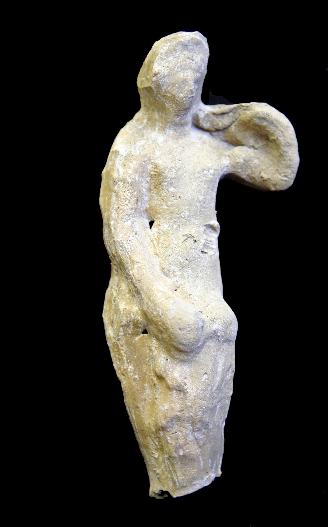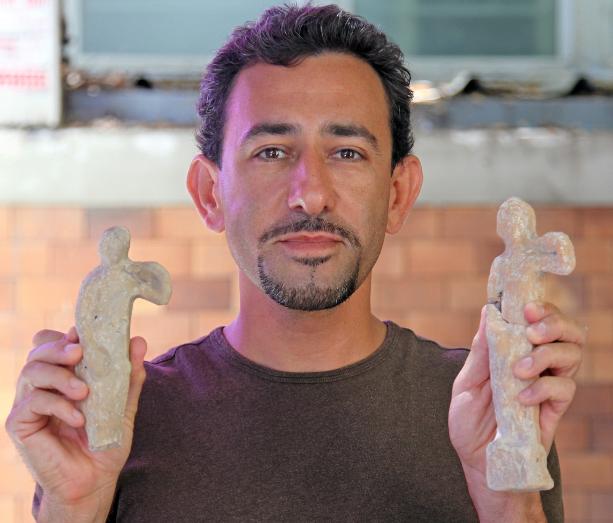An ancient cache containing three figurines of the goddess of love Aphrodite, which was buried in the ground for more than 1500 years, was uncovered as part of the tenth season of excavations conducted by researchers from the Zinman Institute of Archeology at the University of Haifa, led by Prof. Arthur Segal and Dr. Michael Eisenberg.

An ancient cache containing three figurines of the goddess of love Aphrodite, which was buried in the ground for more than 1500 years, was uncovered as part of the tenth season of excavations conducted by researchers from the Zinman Institute of Archeology at the University of Haifa, led by Prof. Arthur Segal and Dr. Michael Eisenberg.
"It is possible that in the fourth century AD, when Christianity was slowly becoming the dominant religion in the Roman Empire, there were still a few residents in Sosita who remained loyal to the goddess of love and asked for her to be hidden and preserved," estimated Prof. Segal.
The hidden figurines were found when the researchers uncovered a shop found in the southeast corner of the forum area of Susita - the central public area of the Roman city that was established in the second century BC, existed in the Roman and Byzantine periods and was destroyed by a great earthquake in 749 AD. According to the researchers, it was clear that they tried to hide the figurines and they were indeed discovered in their entirety. The figurines are 30 cm high, made of clay and represent the common model of the goddess of love known by researchers as: Venus pudica, meaning the modest Venus. This name was given to the pattern because the goddess stands upright, with her right palm hiding her modest limbs - perhaps another reason to hide her from the new religion that took over the empire.
Even the tenth season at Susita, which is located on top of a mountain 350 m above the Sea of Galilee, in the area of the Susita National Park, yielded many fascinating findings. In addition to the Haifa University researchers, a delegation from the Polish Academy of Sciences in Warsaw and a delegation from Concordia University from Minnesota, USA, also participated in the excavations, which were conducted with the great assistance of the Nature and Parks Authority.
A fascinating find no less than the hidden treasure is the odeion - a theater-like building, but covered and smaller, which was revealed for the first time in Israel. According to the researchers, buildings of this kind were quite common in the Roman period and were intended for performances of poetry readings or music performances before a select and limited audience and while an average theater had about 4000 seats, in an Odeon the number of seats usually did not exceed 600. The uncovering of this structure also hides a fascinating story . This area of the city was completely covered back in the 60s, when the place was an IDF outpost, with about three meters of debris as part of the outpost's shielding. When researchers began excavating this area in 2008, all that was above the surface were three carved stones. The theory put forward by the researchers, which they now know was on the border of fiction, was that perhaps the three stones hide an odeon-type building underneath - as mentioned, a building that had not been discovered at all in Israel until then. To their surprise and delight, the theory turned out to be correct. The excavation works of the building are only at the beginning, but the researchers have already managed to reveal its full extent - a rectangular structure whose other side is a semicircle. According to the researchers, the quality of its construction is excellent and it seems to be dated to the end of the first century BC or the beginning of the first century AD.

Also found in the excavations was the basilica, a covered structure that acts as a substitute for the public area in the forum in rainy weather. This is the second basilica structure to be uncovered in Israel after the Samaria basilica. The preservation and restoration teams working in parallel with the excavators managed to restore one of the columns of the basilica. "Just looking at the restored column is enough to get an impression of the beauty and power of Roman architecture from the second century AD," noted Prof. Segal. The members of the American delegation uncovered a residential quarter, apparently from the fourth century AD, which allows a rare glimpse into the daily life of Susita's residents in the last three centuries of the city's existence. All the houses that have been uncovered are built around a stone-paved courtyard, around which are the living rooms. According to the researchers, this construction indicates that the day-to-day economic activity, including cooking, was mainly conducted in the yard.
"At the end of the tenth season, we discover an extensive public construction boom in the city, apparently in direct relation to the beginning of Herod's reign, in the first century BC. Until today, we assumed that the building boom during his reign was mainly in Jewish cities, but the findings in Susita indicate that the king's influence may also have been on the pagan cities under his rule," the researchers concluded.

6 תגובות
End:
Maybe it's serial production "gods" maybe made in China..
It is surely a statue of a woman, but where is the certainty that it is "Venus/Aphrodite"?
If she is "Ella" I think they would have invested a little more in the work on the statue..
Maybe it's just someone rich who wanted a statue?
Anyway, I'm not a professional, just a curious citizen, but it really doesn't look like a statue of "God"
I don't expect it to be beautiful and intact for 1500 years, but a little chipping wouldn't hurt here..
Again, I'm not a professional, but the pyramids were built long ago 1500 years ago and you can find statues there that are much more designed and beautiful than these.., when it comes to your "god" you do a job no less than 110%..
This is how the Westerners took over the Land of Israel, now everything is clear
hook
What enthusiasm these ugly statues
Fascinating and fun to hear about such interesting findings